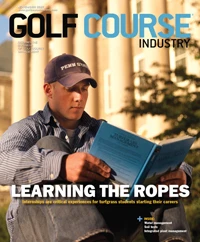I’m sure you’ve heard plenty about the countless hours John Zimmers and his staff put into preparing Oakmont Country Club for the 2007 U.S. Open. You’ve probably read about the speedy greens, the daring tree removal program, the fast-and-firm fairways and almost every other aspect of getting the famed course ready for one of the most successful Opens in recent history.
But what was going on right outside the greens and fairways – in the rough? It turns out Zimmers put almost as much thought and effort into the tall grass as he did the manicured turf.
Now that he’s put the big event behind him and had a chance to catch up on his sleep, Zimmers is happy with the way things turned out.
“More importantly, the USGA and the membership were pleased with the conditions,” he says.
Heading into the Open, Zimmers worried most about the weather forecast for the week.
“Weather is the biggest possible obstacle that is totally out of your control as a superintendent,” he says. “It also has the largest impact on the outcome of the championship.”
Fortunately, Mother Nature mostly played along, and conditions progressed perfectly throughout the week thanks to a little early moisture followed by sunny and dry conditions during play.
There’s little doubt the majority of players’, media’s and fans’ attention was – as always – on the putting surfaces. And Zimmers was prepared for that.
“You always worry the most about the putting greens,” he says. “They’re basically what you get judged on the most, as far as course conditioning goes, and are the most vulnerable.”
In some ways, the demands of Oakmont’s low-handicap membership made that part easier. Green speeds and tough pins used for the event aren’t unusual in the context of regular member play at what many consider to be one of the most challenging courses in the world week in and week out.
“The Oakmont membership prides itself on playing championship conditions on a daily basis,” Zimmers says. “It’s also a benefit that the club has been through this several times before, as this was Oakmont’s eighth U.S. Open.”
One thing, however, that was different than typical Oakmont play was the newly tree-free area surrounding the greens and fairways: the rough.
“Going into the Open, I thought our rough was the weakest part of the course,” Zimmers says. “I was concerned about trying to provide 5-inch-plus uniform rough without it laying over. That’s difficult to achieve.”
The greens usually receive all the attention and most of the babying, but the USGA historically has viewed the rough, as the part of the course that provides the most protection against unreasonable scoring, as important.
“When you think about the U.S. Open, penal rough comes to mind,” Zimmers says.
In the years leading up to the event, Zimmers talked with colleagues and suppliers to see what, if any, types of products and practices might be able to simultaneously strengthen the rough and create more upright growth. The goal was to be appropriately penal but not have balls that were completely unplayable because of hayfield-type rough.
During his research, Zimmers considered the option of using silicon-based products. Soil testing showed there were subsurface deficiencies in the roughs, and silica was one of them. Research from Penn State and other universities suggested silicon-enhanced products provide better cell rigidity and, therefore, more turgidity and improved upright growth. In short, the higher-mown turf in the rough tends to stand up instead of roll over.
Eventually, Zimmers found a prilled, calcium-silicate product that also contained magnesium and other micronutrients. Most importantly, the custom blend – called Excellerator from Excell Minerals – contained the soluble silicon that had been shown to bolster the upright growth that Zimmers needed in the tall grass.
“It ended up turning out just fine – it was uniform, upright, turgid and withstood the wear from the equipment wonderfully,” Zimmers says. “I attribute that to the Excellerator product that we had been applying throughout the entire rough.”
Application rates of Excellerator initially should be enough to correct existing silicon deficiencies. Zimmers started the program in April 2006 at an initial rate of 25 pounds per 1,000 square feet and made subsequent applications in November and April 2007 at the same rate.
For most facilities, an initial rate of 25 pounds per 1,000 square feet is standard, according to Excell Minerals. Follow-up applications should be 10 to 12 pounds per 1,000 square feet every three to four weeks, the company says. The target rate is about 50 pounds per growing season.
The bottom line for Zimmers is presenting the best-conditioned, most challenging golf course possible for Oakmont’s members, guests and the pros. The rough was and will continue to be a big part of that, so Zimmers recognizes the importance of the calcium-silicate program long term. There’s more to the program than just getting rough to stand up, he says.
“We use less fertilizer, and we’ve seen stronger, healthier turf that withstands traffic much better,” he says. “It really greens up, and we think we’ve had some suppression of disease as well. The only thing I would’ve done differently was to start on the program earlier. The results speak for themselves.” GCI
Heather Davies is a freelance writer based in Columbus, Ohio.

Explore the November 2007 Issue
Check out more from this issue and find your next story to read.
Latest from Golf Course Industry
- From the publisher’s pen: Conscientious of a bigger role
- Bernhard and Company partners with Laguna Golf Phuket
- Terre Blanche showcases environmental stewardship
- VIDEO: Introducing our December issue
- Bernhard and Company introduces Soil Scout
- Nu-Pipe donates to GCSAA Foundation’s Centennial Campaign
- GCSAA enhances golf course BMP tool
- Melrose leadership programs sending 18 to 2026 GCSAA Conference and Trade Show





